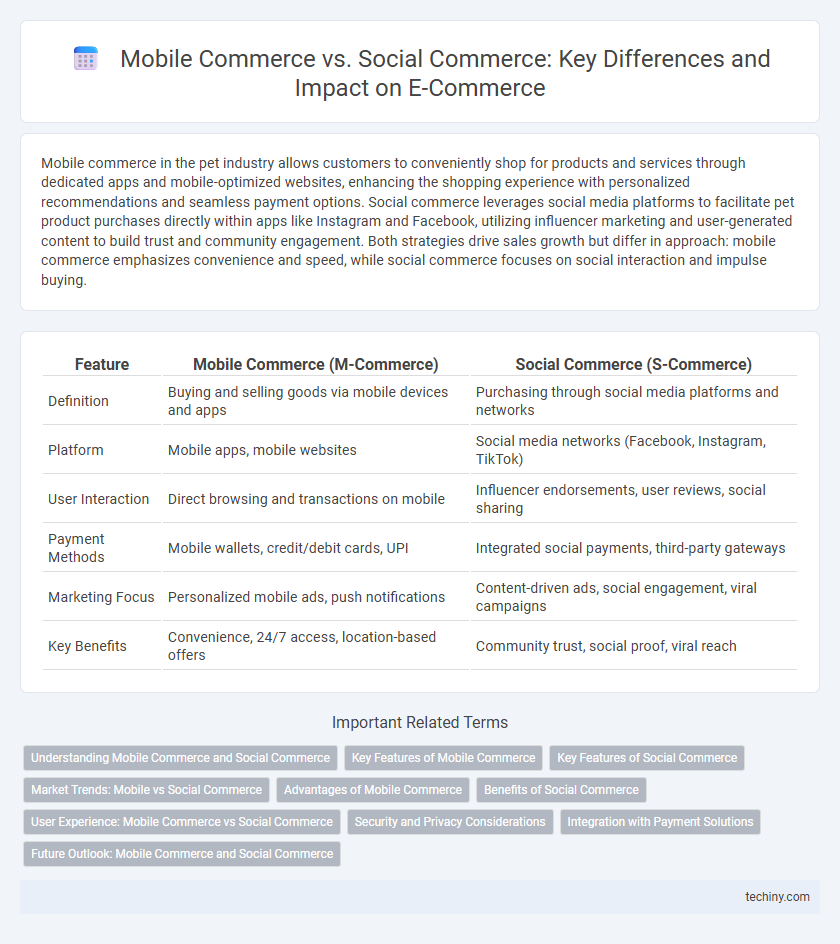Mobile commerce in the pet industry allows customers to conveniently shop for products and services through dedicated apps and mobile-optimized websites, enhancing the shopping experience with personalized recommendations and seamless payment options. Social commerce leverages social media platforms to facilitate pet product purchases directly within apps like Instagram and Facebook, utilizing influencer marketing and user-generated content to build trust and community engagement. Both strategies drive sales growth but differ in approach: mobile commerce emphasizes convenience and speed, while social commerce focuses on social interaction and impulse buying.
Table of Comparison
| Feature | Mobile Commerce (M-Commerce) | Social Commerce (S-Commerce) |
|---|---|---|
| Definition | Buying and selling goods via mobile devices and apps | Purchasing through social media platforms and networks |
| Platform | Mobile apps, mobile websites | Social media networks (Facebook, Instagram, TikTok) |
| User Interaction | Direct browsing and transactions on mobile | Influencer endorsements, user reviews, social sharing |
| Payment Methods | Mobile wallets, credit/debit cards, UPI | Integrated social payments, third-party gateways |
| Marketing Focus | Personalized mobile ads, push notifications | Content-driven ads, social engagement, viral campaigns |
| Key Benefits | Convenience, 24/7 access, location-based offers | Community trust, social proof, viral reach |
Understanding Mobile Commerce and Social Commerce
Mobile commerce drives online sales through smartphones and tablets, enabling seamless transactions via dedicated apps and mobile-optimized websites. Social commerce integrates shopping experiences directly within social media platforms like Instagram and Facebook, facilitating product discovery through user interactions and influencer marketing. Both channels leverage personalized customer data to enhance engagement and streamline the buyer journey in the digital marketplace.
Key Features of Mobile Commerce
Mobile commerce leverages smartphone capabilities such as location-based services, in-app purchases, and seamless mobile payment gateways to enhance user convenience and speed. Key features include optimized mobile websites, secure digital wallets, push notifications for personalized promotions, and biometric authentication for secure transactions. These elements combine to create an efficient shopping experience tailored for on-the-go consumers, distinguishing mobile commerce within the broader e-commerce landscape.
Key Features of Social Commerce
Social commerce integrates e-commerce capabilities directly within social media platforms, enabling seamless product discovery, customer reviews, and real-time social interactions. Key features include integrated shoppable posts, user-generated content, influencer partnerships, and social sharing tools that drive authentic engagement and trust. Enhanced personalization algorithms and community-driven recommendations further boost conversion rates and customer loyalty.
Market Trends: Mobile vs Social Commerce
Mobile commerce continues to dominate global e-commerce sales, accounting for over 70% of total online transactions as consumers increasingly prefer shopping via smartphones and apps. Social commerce is rapidly growing, particularly among Gen Z and Millennials, leveraging interactive features on platforms like Instagram, TikTok, and Facebook to drive impulse purchases and personalized shopping experiences. Market trends indicate that while mobile commerce emphasizes convenience and speed, social commerce excels in engagement and discovery, creating complementary avenues for e-commerce growth.
Advantages of Mobile Commerce
Mobile commerce offers unparalleled convenience with instant access to products and services via smartphones, enabling seamless on-the-go shopping anytime and anywhere. Its advanced features like personalized push notifications and integrated mobile payment systems enhance user engagement and streamline transactions. Moreover, mobile apps leverage location-based services for targeted promotions, increasing conversion rates and customer loyalty.
Benefits of Social Commerce
Social commerce harnesses the power of social media platforms to drive direct purchasing, enhancing consumer trust through peer reviews and influencer endorsements. This form of commerce facilitates seamless interaction, real-time feedback, and personalized recommendations, boosting engagement and conversion rates. By integrating shopping experiences into social networks, businesses gain valuable insights into consumer behavior, enabling targeted marketing strategies and higher customer retention.
User Experience: Mobile Commerce vs Social Commerce
Mobile commerce offers a seamless user experience through dedicated apps and optimized mobile websites that ensure fast loading times, intuitive navigation, and secure payment options. Social commerce integrates shopping directly within social media platforms, providing personalized product recommendations, social proofs like reviews, and one-click purchasing, enhancing engagement and convenience. Both approaches prioritize mobile-friendly interfaces but differ in how they leverage social interaction and platform-specific features to drive conversions and retain customers.
Security and Privacy Considerations
Mobile commerce involves transactions conducted through smartphones and tablets, requiring robust encryption and biometric authentication to protect sensitive user data from cyber threats. Social commerce integrates shopping experiences within social media platforms, necessitating strict privacy controls and transparent data policies to prevent unauthorized access and misuse of personal information. Both platforms demand continuous updates to security protocols to comply with regulatory standards like GDPR and CCPA, safeguarding consumer trust and minimizing fraud risks.
Integration with Payment Solutions
Mobile commerce platforms prioritize seamless integration with diverse payment gateways, supporting digital wallets, credit cards, and biometric authentication for streamlined transactions. Social commerce leverages in-app payment solutions and social wallet integrations, enhancing user convenience by enabling purchases without leaving the social media environment. Both channels emphasize secure, fast payment processing to improve conversion rates and customer satisfaction.
Future Outlook: Mobile Commerce and Social Commerce
Mobile commerce is expected to dominate the e-commerce landscape with continued growth driven by advancements in smartphone technology, faster internet connectivity, and increasing consumer reliance on mobile apps for shopping. Social commerce will evolve as platforms integrate more seamless shopping features, leveraging user-generated content and influencer marketing to boost engagement and conversions. Both models will benefit from AI-driven personalization and augmented reality enhancements, creating immersive and tailored shopping experiences that drive future sales.
Mobile Commerce vs Social Commerce Infographic

 techiny.com
techiny.com